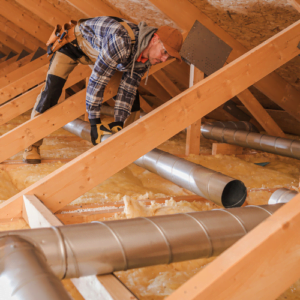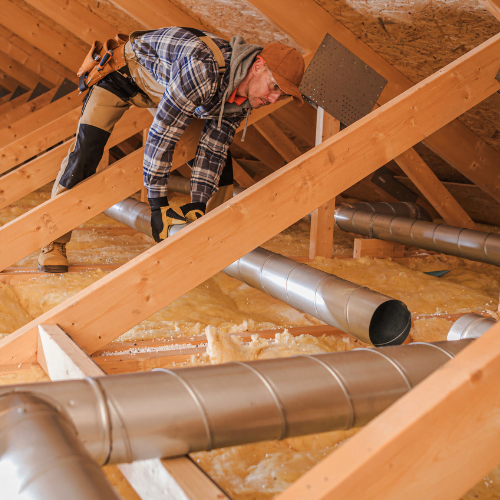Install Ducts and Vents for Your Las Vegas Residential Property
Proper ventilation is crucial for a comfortable living environment in your Las Vegas home. Installing ducts and vents plays a vital role in optimizing the efficiency and effectiveness of your heating and cooling systems. In this blog post, we will highlight the importance of installing ducts and vents in residential properties, while also sharing valuable tips to help you achieve optimal ventilation.
The heating, ventilation, and air-conditioning (HVAC) system is arguably the most complex system installed in a house and is responsible for a substantial component of the total house energy use. A right-sized HVAC system will provide the desired comfort and will run efficiently. Right-sizing of an HVAC system is the selection of equipment and the design of the air distribution system to meet the accurate predicted heating and cooling loads of the house. Rightsizing the HVAC system begins with an accurate understanding of the heating and cooling loads on a space; however, a full HVAC design involves more than just the load estimate calculation; the load calculation is the first step of the iterative HVAC design procedure. This strategy guideline discusses the information needed to design the air distribution system to deliver the proper amount of conditioned air to a space. Heating and cooling loads are dependent upon the building location, sighting, and the construction of the house, whereas the equipment selection and the air distribution design are dependent upon the loads and each other.
For the purposes of this Strategy Guideline, an energy efficient house is defined as one that is designed and built for decreased energy use and improved comfort through higher levels of insulation, more energy efficient windows, high efficiency space conditioning and water heating equipment, energy efficient lighting and appliances, reduced air infiltration, and controlled mechanical ventilation. Specification levels for energy efficient houses have historically been prescribed by beyond code programs that set a percentage better than code for energy use, such as ENERGY STAR®, which requires houses to be 15% more energy efficient than code. Beyond code programs continue to set a percentage better than the improved codes for energy use, raising the bar for whole house energy efficiency.
Ductwork Materials and Configuration The ductwork that is used to achieve the delivery of air from the equipment to the room can have a great impact on comfort in the room. The capacity of a duct to carry air is affected by the resistance within the duct. Typical materials used to make up ductwork are galvanized steel that can be formed into round or rectangular shapes, foil-faced fiberglass duct board that can be formed into angular shapes in the field, or an insulated flexible fabric round duct. Due to the varying friction factors of the different materials, the type of material must be considered in the design process. Increased friction or duct length adds to the total pressure loss. Galvanized steel material ductwork has a lower friction rate than that of flexible duct due to the smoother inside surface of the steel duct; therefore, the fittings chosen will have a greater impact on friction losses in the system. Because air travels easiest in a straight line, a turn in the ductwork will increase the effective length of the duct by more than just the physical length of the turn. For example, a 90° bend will add as much as 35 additional feet of effective length to a duct run, depending on the construction of the ducts. Effective length values for common fittings are listed in Appendix 3 of ACCA Manual D (Rutkowski 2009). The success of a design in either flexible duct or rigid duct depends upon the faithful execution of the design during installation. The ACCA Standard 5 HVAC Installation Specification (ACCA 2010) was introduced in 2010 as an American National Standards Institute (ANSI) standard to improve the core competencies of contractors and to ensure that quality installations occur. Learn more
Why Install Ducts and Vents?
Ducts and vents play a vital role in distributing conditioned air throughout your home. They are responsible for delivering warm or cool air from your HVAC system to each room, ensuring a consistent and comfortable indoor temperature. Without properly installed ducts and vents, you may experience uneven heating or cooling, resulting in hot or cold spots in different areas of your home.
Additionally, ducts and vents help to improve indoor air quality by removing pollutants, allergens, and odors. They facilitate the circulation of fresh air, preventing the buildup of stale air and maintaining a healthy living environment for you and your family.
Professional Installation
While some homeowners may attempt to install ducts and vents themselves, it is highly recommended to hire a professional HVAC contractor for this task. Professional installation ensures that the ductwork is correctly sized, sealed, and insulated to maximize energy efficiency and minimize air leakage.
A qualified HVAC technician will assess your home’s layout and design a ductwork system that efficiently distributes conditioned air. They will also consider factors such as the size of the rooms, the number of occupants, and the placement of furniture to ensure optimal airflow and temperature control.
Professional installation also guarantees compliance with local building codes and regulations. Improperly installed ducts and vents can lead to issues such as air leaks, condensation, and increased energy consumption. By hiring a licensed professional, you can have peace of mind knowing that the installation is done correctly and up to code. Schedule Now
Tips for Duct and Vent Installation
Here are some tips to consider when installing ducts and vents in your Las Vegas residential property:
- Plan the layout: Before installation, carefully plan the layout of your ductwork to ensure optimal airflow. Consider the location of walls, furniture, and other obstacles that may affect the distribution of air.
- Choose the right materials: Select high-quality ductwork materials that are durable and well-insulated. This will help prevent air leakage and minimize energy loss.
- Seal all connections: Properly seal all connections and joints to prevent air leaks. This will ensure that conditioned air reaches its intended destination without any loss.
- Insulate ducts: Insulate your ducts to prevent condensation and reduce heat transfer. This will improve energy efficiency and minimize temperature fluctuations.
- Maintain regular inspections: Schedule regular inspections and maintenance to keep your ducts and vents in optimal condition. This will help identify any issues early on and prevent costly repairs in the future.
- Schedule Now
Conclusion
Installing ducts and vents is a crucial step in maintaining a comfortable and healthy living environment in your Las Vegas residential property. Professional installation by a qualified HVAC contractor ensures that your ductwork is properly sized, sealed, and insulated to maximize energy efficiency and minimize air leakage. By following the tips mentioned above, you can ensure a successful installation and enjoy the benefits of a well-ventilated home.
Call Eco Friendly Air Conditioning and Heating Las Vegas and Schedule a FREE ESTIMATE









